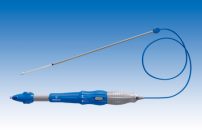Recent randomized trials including low-risk patients showed positive results for transcatheter aortic valve replacement (TAVR) compared with surgical aortic valve replacement. However, surgeons argue that these cases fail to consider patients from daily clinical practice, but rather include a population that has been carefully selected for randomized trials. Patients with non-tricuspid aortic stenosis, with severe…
Cusp Overlap for Higher CoreValve Implantation
Implant depth greater than the length of the membranous septum is an independent predictor of permanent pacemaker implantation. Valve implantation 3 to 5 mm below the aortic annulus in a projection coaxial to the device is recommended. The problem is this is rarely in the annular plane of the valve. Ideal annular plane projection is…
Diastolic Dysfunction and TAVR: Prognosis before and after Procedure
The PARTNER 2 SAPIEN 3 showed baseline diastolic dysfunction is a predictor of clinical events after 2 years of TAVR. As expected, improved diastolic function after procedure immediately changes prognosis. Though these outcomes did meet our expectations, very few studies have shown hard evidence linking diastolic dysfunction and aortic stenosis. All patients included in the…
New Valvular Heart Disease Guidelines with Key TAVI and Mitral Regurgitation Updates
Valvular heart disease management guidelines were updated last week by the AHA and the ACC. The last complete version had been published in 2014; therefore many of its recommendations have become obsolete before the latest evidence. The studies that made the FDA approve TAVI for low-risk patients are probably the most important incorporations. They also…
Considerations for Optimal Device Selection in TAVR
Many studies have tried to answer the question about whether there is a superior device in transcatheter aortic valve replacement (TAVR). Today, there is no evidence to support such claim, and most patients will likely find operator experience more beneficial than any device per se. However, there are certain patients with specific characteristics that might…
After 8-year Followup, Good News for the Self Expandable Valve
As the transcatheter aortic valve replacement (TAVR) gains ground in lower risk populations and with better survival rate, concern over its durability has grown. This study brings us data and good news on the first-generation self-expandable valve after quite a long follow up. It included 990 inoperable or high-risk patients treated with CoreValve in 8…
Post TAVR Regression of Ventricular Mass
This study looked at patients with moderate to severe left ventricular hypertrophy and aortic stenosis treated with transcatheter aortic valve replacement (TAVR). Patients with reduced hypertrophy had lower mortality and fewer hospitalizations at 5 years. It included all moderate to severe risk patients with ventricular hypertrophy undergoing TAVR in the studies and registries PARTNER (I,…
AHA 2019 | RECOVERY: Early Surgery in Asymptomatic Severe Aortic Stenosis
This small randomized study heated the debate about when to intervene aortic stenosis (AS). Putting off surgical valve replacement (SAVR) in patients with asymptomatic AS and waiting for symptom onset with conservative care increased periprocedural risk and all cause cardiovascular death. This study presented by Dr Duk-Hyun Kang during AHA 2019 scientific sessions (simultaneously published…
TCT 2019 | PCI in Stable CAD. Prior TAVR, with TAVR or Never?
Courtesy of SBHCI. This interesting study presented at TCT 2019 and simultaneously published in Am J Cardiol tells us PCI in stable coronary artery disease cannot lower risk in patients with severe aortic stenosis undergoing transcatheter aortic valve replacement (TAVR). Unless patients are symptomatic, most coronary artery lesions do not need revascularization according to researchers.…
TAVR in Bicuspid Has the Same Results in Surgery at Hospital Level
Courtesy of Dr. Carlos Fava. Bicuspid aortic stenosis patients (bicuspid AS) represent a small group and have not been included in the larger transcatheter aortic valve replacement (TAVR) studies, since they present different morphology and asymmetric calcification, which might come along with more paravalvular leak and less accurate positioning. Between 2012 and 2016, 475,315 patients…









